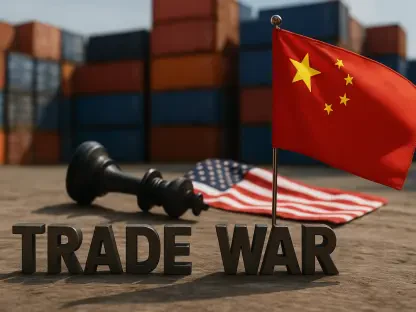On a pivotal trading day, August 5, the U.S. stock market faced a challenging environment as the S&P 500, mirrored by the Vanguard S&P 500 ETF (VOO), grappled with the dual pressures of looming tariff threats and a mixed bag of corporate earnings. Despite President Trump’s bold announcements of steep tariff hikes on pharmaceutical imports—potentially escalating to 250% over the next 18 months—and indications of similar measures targeting semiconductors, the market displayed a surprising degree of composure. A modest premarket uptick of 0.2% for VOO signaled cautious optimism among investors, who seemed to prioritize immediate corporate performance over long-term policy uncertainties. This day’s events unfolded with live updates capturing the delicate balance between external economic pressures and internal market drivers, painting a vivid picture of resilience in the face of potential disruption.
The ability of the market to maintain stability, despite significant headwinds, underscored a fascinating dynamic. VOO’s trajectory saw slight oscillations, dipping to a 0.4% loss by midday before settling at a 0.5% decline by close at 577.35. Such limited volatility hinted at a broader investor sentiment that leaned toward patience, possibly awaiting clearer outcomes from the proposed policies. This scenario set the stage for a deeper exploration into how both tariff threats and earnings reports shaped market behavior, revealing a complex interplay of short-term reactions and long-term considerations.
Market Performance Under Scrutiny
Daily Movements of VOO
The performance of the Vanguard S&P 500 ETF (VOO) on August 5 offered a window into the market’s nuanced response to unfolding events. Starting the day with a slight premarket gain of 0.2%, the index fund suggested an initial wave of optimism among traders, seemingly undeterred by the specter of new tariffs. However, as trading progressed, this early positivity waned, with VOO slipping to a 0.4% loss by midday. By the close, it recorded a modest decline of 0.5%, finishing at 577.35. This relatively tight range of movement reflected a market that, while sensitive to external news, avoided dramatic swings. It appeared that many investors chose to focus on tangible data points rather than speculative fears, maintaining a steady hand in an otherwise uncertain environment.
Beyond the numerical shifts, the day’s performance pointed to a deeper sense of market composure. The muted fluctuations in VOO’s value suggested that the immediate impact of tariff announcements was not as severe as might have been expected. Instead, the market seemed to absorb the news with a degree of stoicism, possibly due to the lack of concrete policy implementation details at this stage. This stability, though fragile, indicated that investors were perhaps more attuned to other influencing factors, such as corporate earnings, which provided a more immediate gauge of economic health. The day’s end, with only a slight loss, highlighted a cautious yet balanced approach to navigating the evolving financial landscape.
Stability Amid External Pressures
Delving into the reasons behind the market’s restrained response, it became evident that the tariff threats, while significant, did not provoke an immediate panic. The announcement of potential tariffs on pharmaceuticals and semiconductors, though alarming in scope, lacked the specificity needed to trigger widespread sell-offs on August 5. Investors appeared to adopt a wait-and-see attitude, possibly anticipating further clarifications or delays in policy rollout. This measured reaction was mirrored in VOO’s limited volatility, which stayed within a narrow band throughout the trading session, reinforcing the notion of short-term stability despite looming uncertainties.
Moreover, the market’s focus seemed to shift away from policy speculation toward more concrete indicators of economic strength. The absence of sharp declines in VOO’s value suggested that many traders were prioritizing current data over potential future disruptions. This approach was likely influenced by the simultaneous release of corporate earnings, which offered a clearer picture of individual company health and sector performance. The ability to maintain relative calm in the face of tariff news underscored a market environment where immediate concerns were overshadowed by a broader confidence in underlying fundamentals, at least for the time being.
Policy Announcements and Economic Implications
Details of Proposed Tariffs
The tariff proposals unveiled on August 5 carried significant weight, with President Trump outlining plans for substantial increases on pharmaceutical imports, potentially reaching up to 250% within the next 18 months. Additionally, hints of similar levies on semiconductors in the near future added another layer of concern for technology sectors. These measures were framed not merely as revenue-generating tools but as strategic efforts to bolster domestic production of critical high-technology products. The emphasis on strengthening local manufacturing signaled a broader policy shift aimed at reducing reliance on foreign supply chains, though the specifics of implementation remained unclear, contributing to a sense of ambiguity among market participants.
The scope of these tariffs, particularly the aggressive timeline for pharmaceuticals, raised questions about their potential to reshape entire industries. While the intention to encourage domestic innovation and production was evident, the immediate economic implications were less certain. Companies reliant on imported materials could face heightened costs, potentially squeezing profit margins and impacting consumer prices down the line. Yet, on this particular day, the market’s reaction remained tempered, as the absence of finalized policies allowed for a degree of speculation rather than decisive action. This policy backdrop set a complex stage for investors, who had to weigh long-term risks against short-term market dynamics.
Market Sentiment on Policy Risks
Investor sentiment regarding the tariff announcements on August 5 leaned toward cautious observation rather than immediate alarm. The lack of a pronounced sell-off in the S&P 500, as tracked by VOO, indicated that many market participants were not yet ready to act on the news alone. Instead, the focus appeared to remain on other drivers, such as corporate earnings, which provided more tangible insights into current economic conditions. This measured response suggested that while the tariff threats were acknowledged as a potential long-term challenge, their immediate impact was perceived as limited, allowing for a semblance of calm to prevail throughout the trading day.
Looking deeper, the market’s composure hinted at a broader understanding of policy cycles and their often-protracted nature. Tariffs of this magnitude typically involve extensive consultation and negotiation periods, which could delay or alter their final form. Investors seemed to factor in this possibility, choosing to hold steady rather than react impulsively to initial announcements. The contrast between short-term market stability and the potential for long-term disruption highlighted a nuanced outlook, where the weight of policy risks was balanced against the likelihood of eventual adjustments or mitigations. This dynamic underscored the complexity of interpreting economic policy in real-time market conditions.
Corporate Earnings as Market Drivers
Highlights of Positive Results
Corporate earnings reports released on August 5 played a pivotal role in shaping market sentiment, with several S&P 500 components delivering standout performances. Pfizer emerged as a notable success, surpassing both earnings and revenue expectations by a significant margin, which bolstered confidence in the pharmaceutical sector. Similarly, Cummins reported results that exceeded forecasts on key metrics, reinforcing optimism within the industrial segment. These strong showings acted as a counterbalance to external uncertainties, providing a sense of stability for investors looking for positive signals amidst a backdrop of policy concerns. The robust performance of such key players underscored the importance of corporate fundamentals in driving market confidence.
The impact of these positive earnings extended beyond individual stock prices, contributing to a broader sense of reassurance within the market. The ability of companies like Pfizer and Cummins to outperform expectations suggested underlying strength in critical sectors, which helped offset fears related to tariff threats. Investors appeared to take solace in these results, viewing them as evidence of resilience despite potential cost pressures on the horizon. This focus on strong corporate outcomes highlighted a market tendency to prioritize concrete financial data over speculative policy impacts, at least in the short term. The day’s trading reflected this sentiment, with gains in these stocks helping to temper broader index losses.
Struggles and Unexpected Turnarounds
Not all earnings news on August 5 painted a rosy picture, as several S&P 500 companies faced challenges that weighed on their stock prices. Caterpillar, for instance, fell short of earnings targets, with management pointing to rising tariff costs as a significant contributing factor, illustrating the real-world impact of policy pressures. TransDigm also disappointed, citing weaker-than-expected projections for future performance, which further dampened investor enthusiasm. Additionally, firms like Yum! Brands saw initial stock declines due to earnings shortfalls, reflecting the market’s sensitivity to underperformance in a climate of heightened scrutiny. These misses highlighted the vulnerabilities within certain sectors, adding a layer of complexity to the day’s market narrative.
Amidst these struggles, however, there were notable stories of recovery that captured investor attention. Hims & Hers Health, despite an initial dip following an earnings miss, managed to rebound into positive territory by midday, driven by underlying growth metrics that reassured traders of its long-term potential. This turnaround underscored a willingness among investors to look beyond headline disappointments when fundamental strengths remained evident. The contrast between companies grappling with immediate setbacks and those showing signs of resilience painted a diverse picture of market sentiment, where individual corporate narratives often carried more weight than overarching policy concerns. Such dynamics revealed the intricate balance investors navigated on this eventful trading day.
Reflections on Market Resilience
Balancing Act of Investor Priorities
Reflecting on the events of August 5, the S&P 500 demonstrated a remarkable ability to weather potential economic storms with only minor turbulence, as evidenced by VOO’s modest closing loss of 0.5%. The day had unfolded with tariff threats casting a long shadow, yet the market’s limited volatility suggested that investors had chosen to focus on corporate earnings as a more immediate barometer of economic health. Strong results from firms like Pfizer and Cummins had provided a stabilizing force, while disappointments from Caterpillar and TransDigm, partly tied to tariff costs, had introduced pockets of concern. This delicate balance between policy fears and corporate realities had defined the trading session, revealing a market adept at compartmentalizing risks.
Looking Ahead to Policy Clarity
As the dust settled on that trading day, attention turned to the need for greater clarity on the proposed tariffs and their eventual impact. The announcements regarding pharmaceuticals and semiconductors had sparked concern, but their lack of immediate effect on the S&P 500 pointed to a window of opportunity for dialogue and adjustment. Moving forward, stakeholders could benefit from closely monitoring policy developments and engaging with industry leaders to mitigate potential disruptions. Additionally, the mixed earnings outcomes had highlighted the importance of robust corporate strategies to navigate rising costs. The resilience shown on August 5 served as a reminder that while challenges loomed, the market retained the capacity to adapt, provided that future uncertainties were met with informed and proactive responses.









